“What’s it mean?”
The guy next to me took a long last drag on his cigarette, flicked the butt onto the road with a practiced panache, and nodded towards a small printed sign posted on the window of the train station.
“It’s talking about the art,” I replied, “the art… there.”
I pointed.
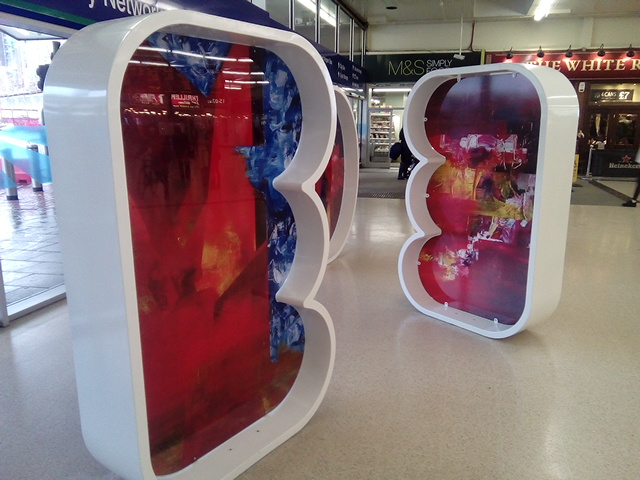
“I guessed that was art,” he said, “but that? What’s that all about?”
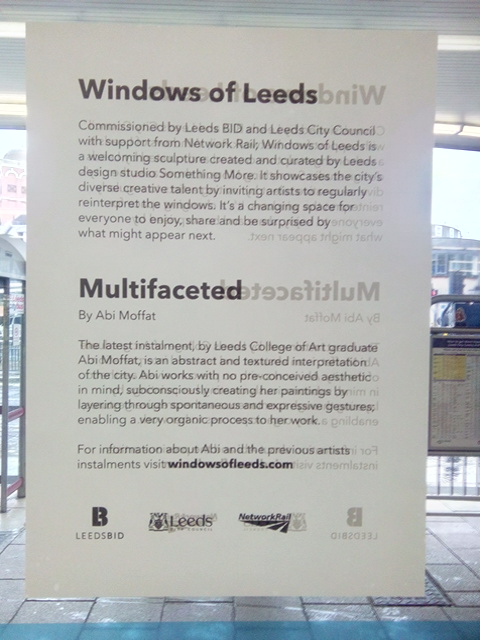
Yesterday afternoon was wet and dreary. I’d just got back from seeing my mum in Wakefield and was hanging around the station waiting for a friend before we went to the opening of the new exhibition at the Henry Moore Institute. I was standing outside with a group of smokers beside the No Smoking sign looking in at the bright, cheerful Windows of Leeds installation. I like this piece and love the story of how it was made (take time to read it, you’ll appreciate the art even more.) I hadn’t realised there was a sign on the window explaining the art within. My smoking companion was reading the sign.
I suppose we both hadn’t anything better to do given the weather.
It’s a very small sign, but you can clearly see it on the Leeds 2023 website.
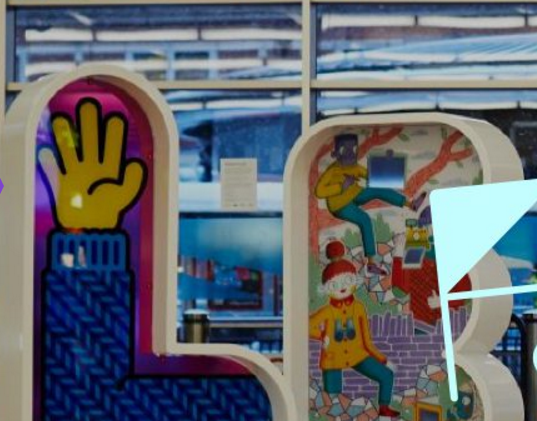
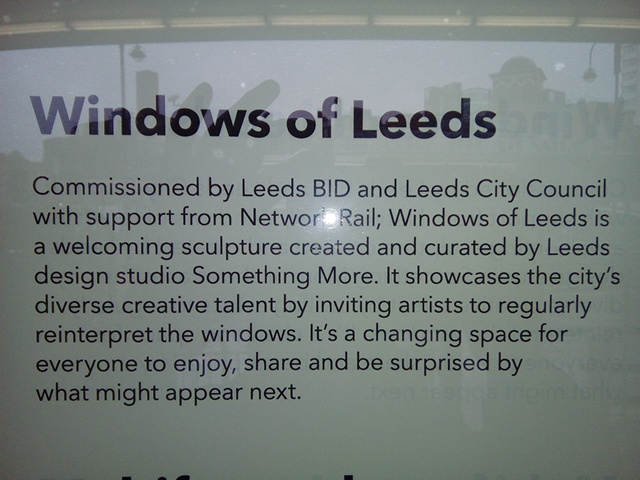
“Commissioned’s a funny name for a piece of art.”
It took a couple of seconds to register his misapprehension.
“No, the piece is commissioned by Leeds Bid and the Council… It’s called “Multifaceted”” I said, not entirely confident of my interpretation. “It’s… well, it says there what it is.”
“I did read that. Which is why I asked you what it meant… you look like the sort of person who’d know. You’ve been gawping at it long enough.”
I take my compliments wherever I find them and beamed at my interrogator.
“It means,” I said, stepping back a little, readjusting my glasses and assuming the pose of artistic expositor, hoping to channel John Berger, circa 1972, “it means… well, it means what it says.”
He stared at the sign. He screwed up his eyes and stared harder.
“Am I just being thick,” he said, “I can’t work out what any of those words mean… am I meant to? I’ve got English GCSE.”
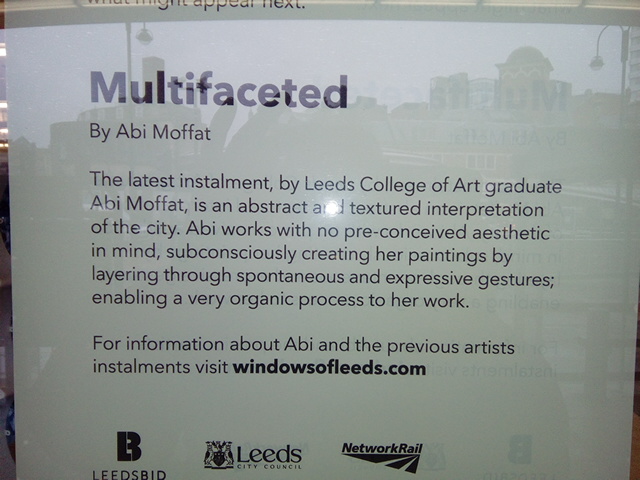
“It’s bollocks, fucking bollocks,” chimed in another of the smoking clique, “fucking hate it.”
“Well, it’s ok to not like something, that’s a legitimate response too,” I said. He was a small, wiry guy in a tattered t-shirt with tattoos in extraordinary places. I never argue with a man with inked cuticles. If he can take that much pain I’m not going to dispute his aesthetic sensibilities.
“I think the artist is just trying to explain how she works,” I said, turning away from Mr blue thumbs, “she just… she just, well, paints what she feels like. When she feels like it?”
The note of questioning in my intonation was not deliberate. It may have been my subconscious layering through a spontaneous and expressive gesture, which is a very organic process. Or it may have been that I was shitting myself.
“Got to go. Nice talking to you guys,” I said, pretending my phone had just vibrated. “Taking a friend to a gallery…”
I scuttled off.
I’m not the best cultural ambassador for Leeds.
If only I’d had the leader of Leeds City Council with me to shout about how great the culture in Leeds is.
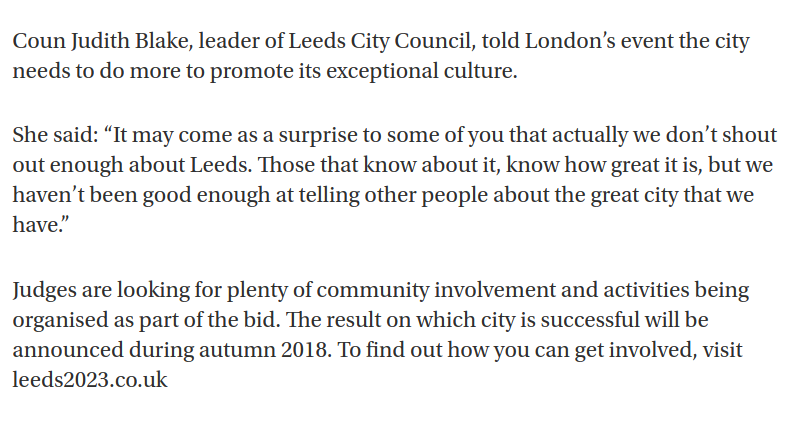
I’m sure she’d have been able to tell those blokes outside the station about the great city we have…
Hi Phil
Long-time no comments from me on your various postings.
This one and one previously on why people don’t like art got me thinking about a response, however.
The points I am going to make roughly address both as in your writings there seem to be common elements as well in that they both relate to what we might call the reception” of Art. This post raises issues about what we might call the uses of Art. The final issue I want to comment on is the use of the word culture. I will say nothing in what follows that I’m sure you don’t already know but for the sake of clarity I will give some back ground to what I think you are talking about.
Firstly, a lot of what you write uses the word Art as a focus but today we tend to use the word culture as you did in a tweet pointing to this post.
Art and culture have traditionally viewed seen as two different realms – art is what happens in art galleries, concert halls, in up-market theatres and when you read the texts of revered authors books borrowed from the public library. Culture is what happens in your life the rest of the time or all the time if you don’t indulge in the Arts. The best people do art and the masses have their own cultures in this kind of view. If you identify as one of the mass, you probably don’t like art because you see it is not for you either because you are barred socially or economically or the experience is opaque to you for any number of reasons. In the case of this post the language in which it is curated.
Of course, over the years four things have happened. First, politically, the attempt was made to bring Art to the people e.g. by lending art reproductions and classical albums from the Library and by having concerts and theatre in the workplace. All very laudable but not very effective.
The nature of Art work itself has evolved in ways that on the one hand sought to make the work itself more meaningful to people – street theatre performance, “fusions” of classical and other more popular musical forms. But often alternatively became more obscure and less obviously related to what people might have assumed Art was about – performance art, music concrete.
Forms of popular culture – TV, cinema, photography, popular music became amenable to the kind of reverential criticism that was traditionally afforded only to Art in its traditional sense. The divide between what is Art and what is culture both in terms of some of the work and some of the criticism was beginning to break down.
Latterly political funding for Art and other “cultural” activities became allied to other social agendas rather than just being a good thing to have around. Arts events had to generate audience numbers, income and at the same time be “accessible” in effect becoming both a business and a social service.
Beyond this, today, Arts and Culture are seen as an economic vehicle on which cities can build either directly by the promotion and sponsorship of the cultural and creative industries so called cultural regeneration or more generally in promoting the city as “a great place to live, work and do business”. The successful city is culturally competitive: it is a Capital City of Culture.
What are the conclusions? To sum up your posts suggest that Art is little more understood and artists liked little more than perhaps they ever were and to that extent arts participation remains a source of social and economic capital for elites. The exception being where as part of the economic bounty community cohesion cultural events are expected to bring aesthetically limited spectacular events are provided by public authorities – e.g. Light Night. Moreover, where some festival or Capital of Culture bid is mounted the process is inevitably selective in the sense that no-one who organises such things wants to see put on events or exhibitions that are perceived to be critical or in any way challenging or even dare I say “upsetting to some viewers”.
This is what civic arts policy has produced. So, that in the end what popular culture that people used to produce for themselves and their communities now must become part of a “mainstream offer” which shows off the diverse city at its best. What has been left out and is now marginal is what used to be called the Avant Garde – Red Ladder Theatre, no grant for you, leaving Art and culture emasculated in terms of its potential to really “inspire” and “make a difference”.
There is certinhaly no need to shout.
Hi John, I agree with much of what you say and think we are in for a lot of cheerful, celebratory, conformist civic culture…
Stay vibrant!
Although to be fair Phil – Hull City of Culture does has this
https://www.hull2017.co.uk/whatson/events/coum-transmissions/
Cosey was of course one of their own so I don’t know whether Leeds will be so risqué.
Be inspired
Sour
How much is the fine for flicking a cigarette butt in the street? Someone like that, no wonder he doesn’t understand Art!
I don’t know how much the fine would be, but to be honest your attitude is probably the reason “someone like that” doesn’t care much about art.